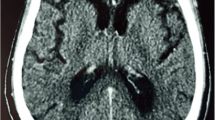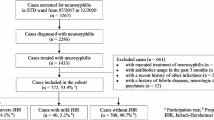Abstract
Neurosyphilis remains to be a challenging diagnostic possibility worldwide. The aim of our study was to identify and report the clinical and laboratory profile of neurosyphilis, comparing features of HIV-infected and HIV-negative patients. A retrospective investigation of all cases of neurosyphilis, defined as positive VDRL test on cerebrospinal fluid, diagnosed at Hospital das Clínicas, Ribeirão Preto School of Medicine between January 1988 and December 2005, was carried out. We identified 35 patients with a mean age of 42.1 years, 28.6% of them HIV infected and 74.3% of them were male. HIV-infected patients were younger (34.6 years), presented with a higher frequency of the early forms of neurosyphilis, higher titers of serum VDRL and higher mean proteinorrachia at the suboccipital level. Neurosyphilis is still characterized by clinical polymorphism and there are significant differences in its epidemiological, clinical and laboratory profile when HIV-infected patients are compared with HIV-negative patients.

Similar content being viewed by others
References
Fleming WL (1964) Syphilis through the ages. Med Clin North Am 48:587–610
Musher DM, Hamill RJ, Baughn RE (1990) Effect of human immunodeficiency virus (HIV) infection on the course of syphilis and on the response to treatment. Ann Intern Med 113:872–881
Hook EW, Marra CM (1992) Acquired syphilis in adults. N Engl J Med 326:1060–1068
Golden MR, Marra CM, Holmes KK (2003) Update on syphilis: resurgence on an old problem. JAMA 290:1510–1514
Johns DR, Tierney M, Felsenstein D (1987) Alteration in the natural history of neurosyphilis by concurrent infection with the human immunodeficiency virus. N Engl J Med 316:1569–1572
Berry CD, Hooton TM, Collier AC, Lukehart SA (1987) Neurologic relapse after benzathine penicillin therapy for secondary syphilis in a patient with HIV infection. N Engl J Med 316:1587–1589
Carmo RA, Moura AS, Christo PP, Morandi AC, Oliveira MS (2001) Syphilitic meningitis in HIV-patients with meningeal syndrome: report of two cases and review. Braz J Infect Dis 5:280–287
Flood JM, Weinstok HS, Guroy ME, Bayne L, Simon RP, Bolan G (1998) Neurosyphilis during the AIDS epidemic: San Francisco, 1985–1992. J Infect Dis 177:931–940
Katz DA, Berger JB, Duncan RC (1993) Neurosyphilis: a comparative study of the effects of infection with human immunodeficiency virus. Arch Neurol 50:243–249
Souza MC, Nitrini R (1997) Effects of immunodeficiency virus infection on the manifestations of neurosyphilis. Neurology 49:893–894
Katz DA, Berger JR (1989) Neurosyphilis in acquired immunodeficiency syndrome. Arch Neurol 46:895–898
Zetola NM, Klausner JD (2007) Syphilis and HIV infection: an update. Clin Infect Dis 44:1222–1228
Gerbase AC, Rowley JT, Heymann DHL, Berkley SFB, Piot P (1998) Global prevalence and incidence estimates of selected curable STDs. Sex Transm Inf 74:12–16
Nicoll A, Hamers FF (2002) Are trends in HIV, gonorrhoea, and syphilis worsening in western Europe? Br Med J 324:1324–1327
Chen ZQ, Zhang GC, Gong XD et al (2007) Syphilis in China: results of a national surveillance programme. Lancet 369:132–138
Simms I, Fenton KA, Ashton M et al (2005) The re-emergence of syphilis in the United Kingdom: the new epidemic phases. Sex Transm Dis 32:220–226
Marcus U, Kollan C, Bremer V, Hamouda O (2005) Relation between the HIV and the re-emerging syphilis epidemic among MSM in Germany: an analysis based on anonymous surveillance data. Sex Transm Infect 81:456–457
Spina-França A (1967) Líquido cefalorraqueano. In: Tolosa APM, Canelas HM (eds) Propedêutica neurológica, 1st edn. Fundo editorial Procienx, São Paulo, pp 403–425
Centers for Disease Control (1992) 1993 Revised classification system for HIV infection and expanded surveillance case definition for AIDS among adolescents and adults. MMWR 41:17
Hollander H (1988) Cerebrospinal fluid normalities and abnormalities in individuals infected with immunodeficiency virus. J Infect Dis 158:855–858
Roos KL (1998) Pearls and pitfalls in the diagnosis and management of central nervous system infectious diseases. Semin Neurol 18:185–196
Wicher K, Horowitz HW, Wicher V (1999) Laboratory methods of diagnosis of syphilis for the beginning of the third millennium. Microbes Infect 1:1035–1049
Timmermans M, Carr J (2004) Neurosyphilis in the modern era. J Neurol Neurosurg Psychiatry 75:1727–1730
Sethi S, Das A, Kakkar N, Banga SS, Prabhakar S, Sharma M (2005) Neurosyphilis in a tertiary care hospital in north India. Indian J Med Res 122:249–253
Salhi B, Heilpern KL (2008) Update on emerging infections: news from the Centers for Disease Control and Prevention. Symptomatic early neurosyphilis among HIV-positive men who have sex with men—four cities, United States, January 2002–June 2004. Ann Emerg Med 51:101–105
Aldave AJ, King JA, Cunningham ET (2001) Ocular syphilis. Curr Opin Ophthalmol 12:433–441
Glatt AE, Stoffer HR, Forlenza S, Altieri RH (1991) High-titer positive nontreponemal tests with negative specific treponemal serology in patients with HIV infection and/or intravenous substance use. J Acquir Immune Defic Syndr 4:861–864
Marra CM, Maxwell CL, Smith SL, Lukehart SA, Rompalo AM, Eaton M, Stoner BP, Augenbraun M, Barker DA, Cobertt JJ, Zajackowiski M, Raines C, Nerad J, Kee R, Barnett SH (2004) Cerebrospinal fluid abnormalities in patients with syphilis association with clinical and laboratory features. J Infect Dis 189:369–376
Author information
Authors and Affiliations
Corresponding author
Rights and permissions
About this article
Cite this article
Gitaí, L.L.G., Jaláli, P.S. & Takayanagui, O.M. Neurosyphilis in the age of AIDS: clinical and laboratory features. Neurol Sci 30, 465–470 (2009). https://doi.org/10.1007/s10072-009-0134-7
Received:
Accepted:
Published:
Issue Date:
DOI: https://doi.org/10.1007/s10072-009-0134-7




